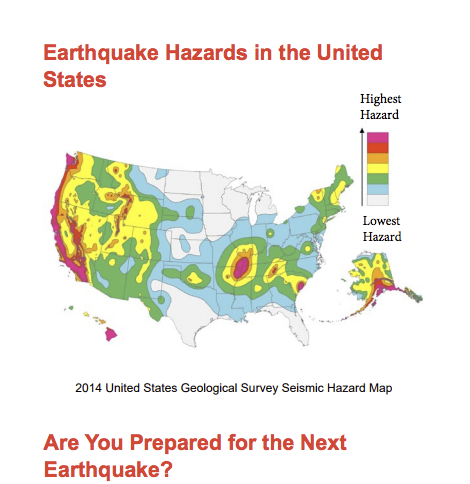VLMK’s Holiday Gift Guide
Community • November 29, 2017
With Thanksgiving over, the holiday gift giving season is now officially on! This means you now have to find the perfect gift for your brother-in-law and Aunt Barbara. But not to worry, VLMK has prepared some ideas that we’re sure will excite everyone on your list. Well, maybe that’s overstating it a bit, but we do have some suggestions for those hard to buy for folks. These probably won’t be as exciting as your first Atari game console or Cabbage Patch doll, but they may stand the test of time better and will be appreciated in the long run.
Our suggestions come from the fun holiday folks at FEMA and the American Red Cross who’ve put together guides. We’re talking Preparedness here – earthquakes and emergencies. These guides list those things that everyone knows they should have, but we keep putting it off.
Some of the basic items like food, medicines, and proper clothing are givens that everyone either has, or should assemble on their own. In our house with teenagers, we never know when a small army of friends will arrive, so we have a food stockpile that looks like a miniature Costco. However, the following items likely haven’t made it on the weekly shopping list, but are must-haves in an emergency and might make a great gift.
- EQ Checklist: We’ll start with an easy one that’s free. You can download FEMA’s Earthquake Checklist here, print it and bind it with a festive bow and you’ll have a great stocking stuffer! It may not win the white elephant exchange, but maybe there will be points for thinking outside the box.
 First Aid Kit: This is a basic item that’s good to have around the house, in the car, and a small one for those occasional day hikes. You can’t go wrong with giving one of these. The American Red Cross has an online store you can purchase these from, but there are lots of places to get them as well. REI is also a good place, especially for more compact kits.
First Aid Kit: This is a basic item that’s good to have around the house, in the car, and a small one for those occasional day hikes. You can’t go wrong with giving one of these. The American Red Cross has an online store you can purchase these from, but there are lots of places to get them as well. REI is also a good place, especially for more compact kits.- Emergency Radio: There are several options available and recommendations are to have one that can use batteries or has a hand crank. Ideally, one that can receive weather alerts from NOAA is also recommended. Again, the Red Cross store has these and there are many on Amazon as well.
- Water Storage Containers: This is exciting stuff here! The Red Cross and FEMA both recommend having 1 gallon per person, per day. If you consider a big earthquake, it’s possible you could need two to three weeks of water supply. For our family of four, that’s 56 to 84 gallons of water. Not a small amount. There are options available that range from small 5 to 7 gallon stackable containers, to larger 55 gallon plastic drums, complete with a hand siphon pump and water treatment drops. Cabela’s and Amazon both have containers. Make sure that containers are stored or braced so they won’t fall and rupture in an earthquake.
- Water Filter: As backup for water storage, a manual water filter is also a good idea. Our family has a water filtration system that we use for backpacking. In an emergency it can be used to filter water from other sources—maybe a local river or lake– and could be a great gift idea. REI is good bet for lots of options with manual filter systems.
- Emergency Blanket: These can come in all sizes and shapes. I like the idea of having this in the emergency car kit. For our family, if we need to shelter in place at home, we have an attic full of sleeping bags. However, if an earthquake or other emergency finds us at work or traveling about and unable to get home for some extended period, these could be very helpful. My wife has a fleece travel blanket for the car that seems like an all around handy item to have. However, the more traditional emergency blankets (they kind of resemble tinfoil) will help retain body heat, can be inexpensive and are readily available from a variety of sources. The American Red Cross, REI, and Amazon are all good bets and have options that start as low as a few dollars.
- Furniture Restraints: These are good ones for the stocking and are used to anchor tall cabinets, bookcases, TV’s, or other furnishings and appliances so they won’t tip, fall or roll in an earthquake. Options are available from many stores including Lowes, Home Depot, Target and of course Amazon.
- Flashlights: It’s good to not only have these around the house, but an extra one in the car or at the office. LED flashlights have become very popular and put out a lot of light. I also really like the headlamp versions too, which we use for backpacking and are great if you have to walk in the dark or need both hands free. You probably won’t go wrong looking at Home Depot, Costco, the local hardware store or Amazon for flashlights. For good headlamps, REI has a great selection—just don’t look straight at them when testing for brightness.
- Batteries: Chances are you’ll need these for all the kids toys anyway, so might as well get extras. Bring a couple sleeves of the AA and AAA as a host gift for the family gathering and you’ll probably be a hero. The D cell and 9-volts are a good gift for the handy man who has big flashlights or needs to change all the smoke alarm batteries (usually at 2:00 a.m. because nobody can tell which one is chirping). I love the great big packages at Costco, but Home Depot and others have started selling larger packages, as well.
- Fire Extinguisher: One of these should be in every home and office and can be purchased at your local hardware store or Home Depot. Also—here’s our public service announcement—be aware that Kidde, once of the largest manufacturers of fire extinguishers, just announced a recall that affects some of their most popular home models. If you have fire extinguishers in your home (or even on a personal watercraft), you can check your models with the US Consumer Protection Agency here and register to get replacements from Kidde here.
- Camp Stove and Gear: If your idea of camping is checking in at the Sheraton, there’s nothing like a large earthquake to potentially give you a crash course in the finer art of camping. With prolonged utility outages an almost certainty, people will be advised to shelter in place (a.k.a camp at home –either in the house if it’s safe or in the back yard if the structure is damaged.) Having a basic camp stove with extra fuel canisters might be just thing for your holiday list and can be purchased from a variety of stores or online. Having sleeping bags and even a tent are also highly recommended. Who knows, you might even get the bug to try these out without an emergency. There’s a whole world of parks out there to explore just for fun!
- Basic Tool Kit: This one might be for Aunt Barbara who might not have a garage full of tools. It’s always a good idea to have a basic tool kit in the car and I recently made sure that my wife and teenage daughter both had one that was ready to roll with their vehicles, though many of the same tools can be useful at home too. Some of the basics include a multi-function screw driver, pliers, an adjustable crescent wrench, utility knife, wire, duct tape and some hose clamps. In emergencies, these tools can be used around the house for things like shutting off the gas or water valves if needed following an earthquake. Emergency lists also suggest a multi-tool like a Leatherman, manual can opener and pipe wrench –maybe not so much for the car, but good at home. For basic tools, Harbor Freight has inexpensive options and coupons that make assembling a kit of emergency tools very affordable.
One more suggestion that won’t cost you anything: Use that holiday gathering with family to make an emergency plan, talk about where you’ll meet up and how you’ll contact each other after an emergency.
I hope you’ve enjoyed our holiday gift guide. For more ideas and a complete list of earthquake and emergency preparedness items, the following resources may be helpful:
- FEMA Checklist
- Ready.gov
- CDC
- Red Cross General Emergency Checklist or more specific earthquake information
- And our local Tualatin Valley Fire and Rescue has lots of references and links here
Happy Holidays from VLMK Engineering + Design!

This post was written by Trent Nagele, PE, SE. Trent is a Principal Structural Engineer with VLMK Engineering + Design. He currently serves as a member of the Oregon Seismic Safety Policy Advisory Commission (OSSPAC) and was the co-chair of the Critical Buildings Task Group that helped write the Oregon Resilience Plan.






